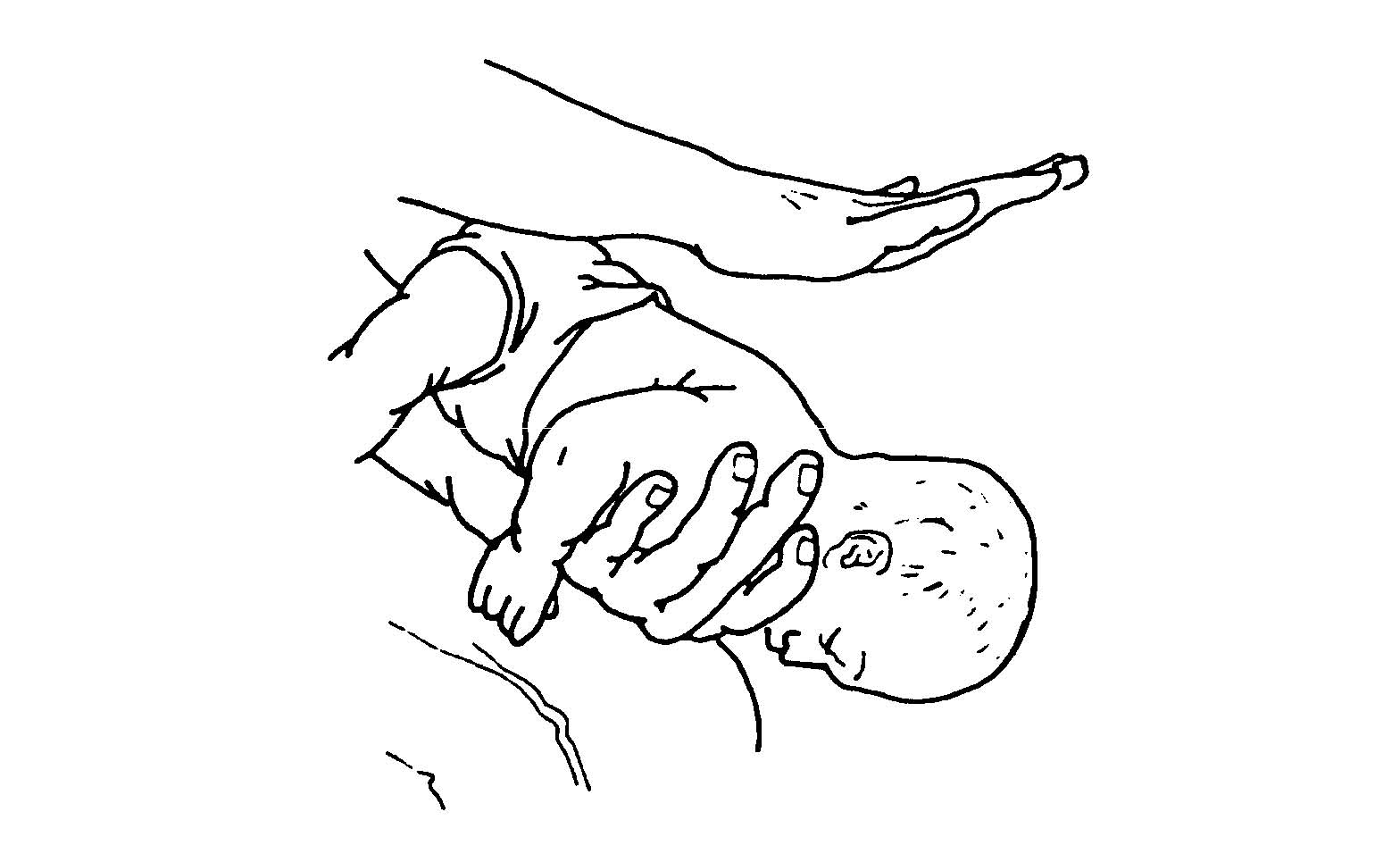Cardiopulmonary Resuscitation
Lesson 7: Remove an Airway Obstruction in a Child or Infant
7-3
7-3. REMOVE UPPER AIRWAY OBSTRUCTION IN A CONSCIOUS INFANT
If a head or spinal injury is suspected, place the infant on a firm surface and administer chest thrusts and finger sweeps (no backblows) as needed. If a head or spinal injury is not suspected (for example, the infant is choking on something he just swallowed), use the procedures given below to remove the obstruction. The rescuer should be in a kneeling or sitting position. (Note that backblows are administered to infants, but not to children or adults.)
a. Call for Help. Call for help, but do not leave the casualty or delay administering chest thrusts in order to seek help. You may need someone to take you and the infant to a medical facility while you continue to perform lifesaving measures.
b. Position Infant for Backblows.
(1) Small infant. Roll the infant's body lengthwise over your arm so the infant is straddling your forearm with his rear toward you and his back up as shown in figure 7-1. Support the infant's head with the thumb and fingers of your hand. Rest your forearm on your thigh to provide support. Be sure the infant's head is lower than the trunk of his body.
Figure 7-1. Administering backblows to a small infant.
(2) Large infant. If the infant is too large to straddle your arm, lay the casualty's body across your thighs with his head lower than the trunk of his body. Position the arm that will not be used to administer backblows under the infant's body so that the hand supports the infant's head and neck. The forearm under the infant's chest will provide a firm surface for the backblows.
c. Administer Backblows. Administer five glancing backblows (figure 7-1). A backblow is administered by striking the infant on the spine between his shoulder blades with the heel of your free hand. The five blows should be delivered within 5 seconds.
d. Position Infant for Chest Thrusts. Chest thrusts are used instead of abdominal thrust because the force of abdominal thrusts could injury the abdominal organs of an infant.
(1) Small infant. Place your free arm over the infant's back with your arm over his spine and your hand resting on the back of his head. Turn the infant over so he is now positioned with his face up and you are supporting the back of his head in the palm of your hand. Rest your forearm on your thigh. Make sure the infant's head is lower than his trunk. The forearm under the infant's back will provide the firm surface needed for the chest thrusts.
(2) Large infant. If the infant is too large to straddle your arm, turn the infant over and lay his body across your thighs with his head lower than the trunk of his body. Put your arm (the arm not being used to deliver chest thrusts) under the infant's head and neck. The forearm under the infant's back will provide a firm surface for the chest thrusts.
e. Administer Chest Thrusts. Chest thrusts are used rather than abdominal thrusts due to the danger of injury to abdominal organs from abdominal thrusts. The chest thrusts are performed in the same manner as are CPR chest compressions for infants (paragraph 6-6) except the thrusts are delivered at a somewhat slower rate.
(1) Draw an imaginary line on the casualty's chest connecting his nipples.
(2) Place the index finger of your free hand just under the imaginary line on top of the infant's sternum.
(3) Place your middle and ring fingers on the sternum so that they are below (closer to the infant's feet than) your index finger.
(4) Lift your index finger from the infant's sternum.
(5) Press straight down with the tips of the middle and ring fingers so the sternum is depressed 1/2 to 1 inch.
(6) Relax pressure without removing your fingertips from the compression site and allow the sternum to return to its normal position.
(7) Repeat the chest thrusts until a total of five chest thrusts have been administered or the object has been expelled.
f. Repeat Backblows and Chest Thrusts. Repeat the series of five backblows and five chest thrusts until the obstruction is expelled or until the infant looses consciousness.
(1) If the obstruction is expelled, check the infant for breathing. Administer rescue breathing or CPR (lesson 6) as needed if the infant does not resume breathing on his own.
(2) If the infant loses consciousness, use the procedures given in paragraph 7-4.


